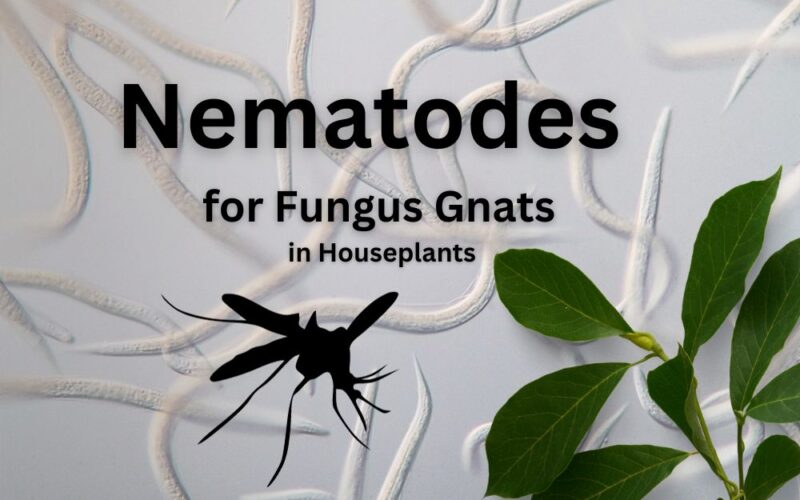If you spot small black gnats around your indoor plant along with the symptoms of root damage (overall weakness and foliage yellowing) you must be concerned about fungus gnats’ infestations. There are various ways to get rid of them but using beneficial Nematodes for Fungus Gnats in houseplants will work well.
In this article, I first will tell you about fungus gnats in houseplants and their favourite environments. After that, you will get familiar with beneficial Nematodes for fungi gnats in houseplants and will learn how they can control these pests. I also provide you with tips to use them in indoor plants that will help you raise their efficiency. Let’s start.
➡ You can also hear the audio version of this article. (about 5 minutes)
What Are Fungus Gnats in Houseplants?

Fungus gnats, also known as Fungus Flies or Sciarid Flies, are common tiny bugs on houseplants, flowers, and herb pots. These small flies can inflict serious damage on various plants, especially those in the process of propagation.
Their life cycle begins with laying eggs in compost or soil, leading to the development of larvae (similar to tiny white worms in houseplant soil) that often feed on young plants and seedlings. These larvae thrive in damp conditions and organic plant matter, posing a threat to plant roots and causing damping off and seedling collapse.
In large numbers, the larvae can also spread soil-borne diseases like Pythium. Once the larvae mature into adults, they become a nuisance, forming small clouds of flies when disturbed.
Fungus gnats are attracted to moist soil and dark, humid environments, making them a common pest for houseplants. They are more interested in the soil than the plants themselves, and they can be found in various types of plants. Overwatering houseplants or having a high number of them can create an ideal environment for fungus gnats, leading to an annoying infestation. so, the risk of soil gnats infestation will increase in pots without drainage holes.
What Are Beneficial Nematodes for Fungus Gnats in Houseplants?
To combat Fungus Gnats, the Fungus Fly Killer utilizes Steinernema feltiae nematodes for effective biological control. They are the best nematodes for fungus gnats in houseplants. These nematodes enter the larvae through natural openings, such as the mouth, and feed on the larvae’s contents.
The nematodes produce a natural bacterium inside the larvae, leading to its death. Infected larvae are broken down by the nematodes, which also reproduce inside the larvae, releasing more nematodes into the surrounding area. Infected pests change colour and typically die within 7-10 days.
How Do Nematodes for Fungus Gnats Work?

Nematodes play a crucial role in breaking the lifecycle of fungus gnats. They move through moist soil like worms, seeking out and burrowing into the larvae. Inside the larvae, they reproduce and kill it. Emerging from the larvae, they continue the cycle, targeting more larvae until all are eradicated. Once all the fungus gnat larvae are eliminated, the nematodes die out as they have nothing left to reproduce inside.
Why You Should Use Nematodes for Fungus Gnats in Houseplants
Here is a list of the advantages of using nematodes for fungus gnats in houseplants.
- Natural and organic control without chemicals or pesticides.
- Safe for humans, children, and pets; no gloves needed.
- Environmentally friendly, targeting only the intended pest and safe for beneficial wildlife.
- No risk of pests developing resistance.
- Flexible application with no restrictions on flowering plants.
- Easy to use – just add water.
- Effective against larvae, preventing the most damage.
How to Use Nematodes for Fungus Gnats in Houseplants?

In this part, I will answer some of the frequent questions that people usually ask about using nematodes fungus gnats in houseplants. let’s find them.
When to Apply Nematodes in Houseplants?
Apply Fungus Fly Killer Nematodes when plant damage or Fungus Fly activity is observed, as these pests can occur year-round. In addition, you must use them when soil temperatures are above 10°C for at least a few hours per day (April to October).
How Many Nematodes Do I Need in House Plants?
Use 1 x 5 million nematodes to treat up to 10m2 (or up to 25 house plants).
What Are Conditions for Nematode Application in Indoor Plants?
Apply on humid or wet days, as nematodes are UV-sensitive and won’t survive in bright, sunny conditions. Apply in the morning or evening to utilize optimum humidity levels. Soil or compost temperatures should be above 10℃ for nematodes to be active.
How to Apply Nematodes for Fungus Gnats in Houseplants?
- Mix the pack contents with lukewarm water thoroughly based on instructions.
- Apply immediately after mixing.
- Pour the solution into houseplant pots, seed trays, or containers, directly into the growing media/compost, using all the solution between treated pots.
- Ensure the soil remains moist for 2 weeks post-application. Repeat applications may be necessary after 4 weeks to prevent the buildup of fresh Fungus Fly larvae.
Pro Tips to Use Nematodes for Fungus Gnats in Houseplants

- Store the package in the fridge (4°C) until use; do not freeze.
- Water the soil further afterwards to wash the nematodes into the soil.
- Keep the soil moist for 2 weeks to aid nematode effectiveness.
- Use the entire pack in one go; do not store opened packs or made-up solutions.
How Long Does It Take to Work?
Depending on the severity of the Fungus gnat infestation in houseplants and environmental conditions, it usually takes about 2 weeks for beneficial nematodes to work. After that, you will see the population of Sciarid Flies will decrease and finally all of them will be killed.
Conclusion
In this post, I tried to give you a comprehensive guideline about beneficial Nematodes for fungi gnats in houseplants. now, you what are sciarid fly nematodes, and how you can use them to control these tiny bugs in houseplant soil.
Have you ever used biological agents to control pests? Can you tell us about your experiences? Please share your ideas and experiences with our readers below this page.

Elahe Rabiei
Hi, I’m Elaheh. My Academic major is plant protection, and houseplants are my expertise. As a houseplant lover, my house is full of indoor plants and it is my passion to take care of them. Hence, I’m here to share my knowledge and experience about growing healthy houseplants. I am also a plant protection advisor, so feel free to ask me any questions you may have.

